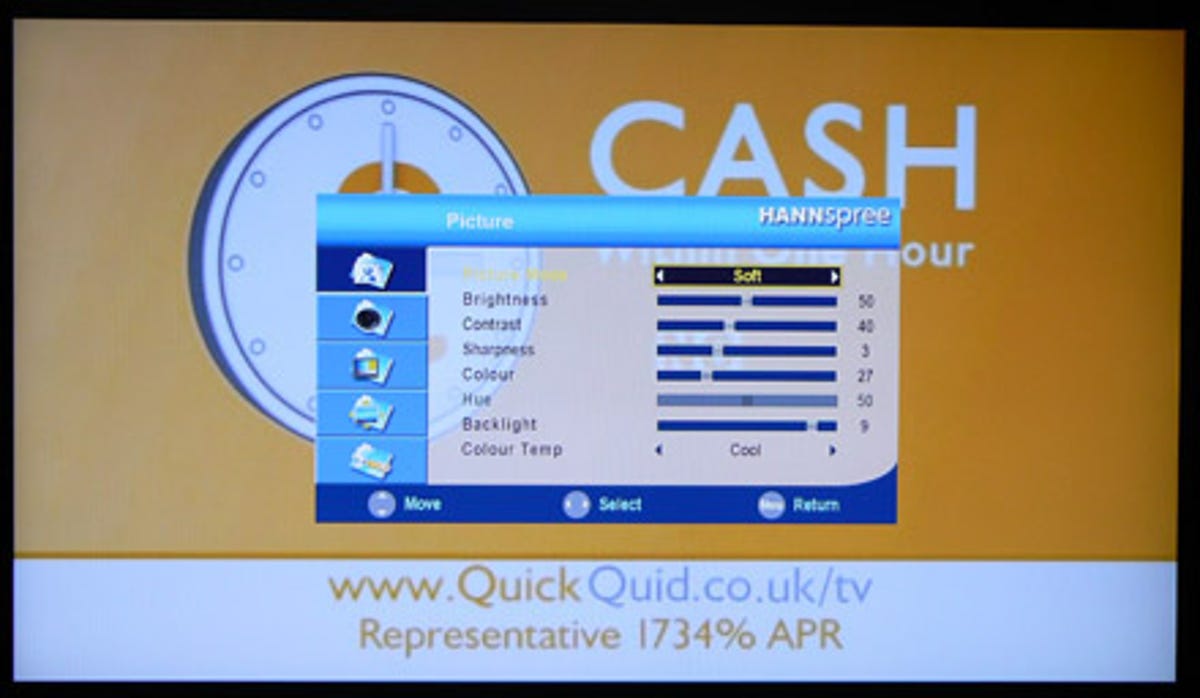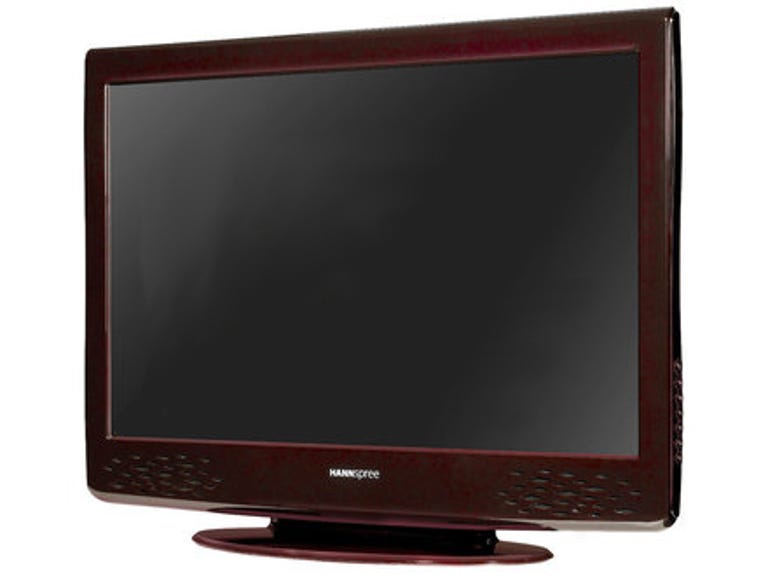 Why You Can Trust CNET
Why You Can Trust CNET Hannspree Hannsjoy ST288MAR review: Hannspree Hannsjoy ST288MAR
The 28-inch Hannspree Hannsjoy ST288MAR LCD TV is certainly cheap, and it definitely looks cheerful. But its lack of picture-processing features means its images have a rough and ready quality to them.
Hannspree made a name for itself by producing low-cost monitors that offer plenty of features at a low price. It's also created a number of novelty TVs shaped like animals and fruits. This time around, it's relying less on novelty shapes, and more on eye-catching colours, as shown by the glossy red, 28-inch, 1080p Hannsjoy ST288MAR LCD TV.
The Good
The Bad
The Bottom Line
It's available for around £200.
User interface
The menu systems on today's high-end TVs are becoming ever more complex and flashy, but the ST288MAR is definitely more old-school in this regard, which isn't all that surprising, given its price.
The functional and static menus are graced with a splash of colour here and there, but lack the flashy animations that you now find on premium models. Still, the simplicity of the menu system means it's quick and easy to get at the picture and audio settings. You get a decent amount of control over these settings too, with picture options including backlight control and the usual colour and contrast settings.

This set's remote control is fairly chunky, but it does have large buttons. The layout is good, with the info and electronic-programme-guide buttons neatly placed next to the central control pad. Still, the TV can be sluggish to respond to the remote, which becomes frustrating after a while.
The TV's EPG isn't very impressive. It uses a vertical layout, with the channel names and numbers listed on the left-hand side and the upcoming shows for the currently selected channel displayed on the right. This makes it much harder to compare what's on at any given time across multiple channels, because you have to actually hop between them. With a traditional, horizontal EPG layout, you can see programme clashes at a glance.
Worse, though, is the fact that, to view the EPG listing for a different channel, the TV tuner actually has to change to that channel first. As channel changes typically take around 2 seconds, this makes navigating the EPG slow and tortuous. If you use your TV with a set-top box for a service like Sky or Virgin Media, this may not be an issue for you, but it's definitely worth bearing in mind if you mostly tend to watch TV via Freeview.
Design and connections
The ST288MAR stands out from the pack largely thanks to its glossy red finish. The red looks quite striking and isn't as overpowering as it sounds. On the downside, though, the bezel around the screen is quite thick by today's standards.
When it comes to the range of connections on offer, the TV doesn't fare too badly. There are two HDMI inputs, so you can have, say, a Sky+HD box connected at the same time as a PlayStation 3. You also get a set of component inputs for older hi-def kit like the original Xbox 360, along with a Scart socket, PC input and composite input. If you were to use it as a primary TV, a third HDMI port would have come in handy, but, given the size of the telly, we think it's most likely to be used in a bedroom or kitchen, so two HDMI ports is probably enough.
What this model lacks, though, is a USB port -- something now found on many rivals. There's a hole in the chassis for a USB port on the left-hand side, but this is blanked off, so perhaps it's only available on a step-up model.
This omission is a shame, as many of today's small TVs allow you to play back DivX and Xvid video files, along with JPEG picture and MP3 music files, via their USB ports. Some, such as the Logik L24DVDB21, also allow you to record live TV to USB hard drives or memory keys. The ST288MAR lacks all of these features, sadly.
Picture quality
Unlike most of today's TVs from bigger-name manufacturers, the ST288MAR doesn't have a Freeview HD tuner onboard. As a result, you're limited to receiving standard-definition TV channels, which is a tad disappointing, especially as the TV has a 1080p panel. Reception is good, though, unlike some other cheap sets we've used. In fact, we didn't experience any break-up at all with this set during our test period.
The first time you clap eyes on the ST288MAR, you'll find there's something distinctly odd about it -- and we're not talking about the glossy red colour scheme. Rather, we're referring to the screen's weird aspect ratio.
Whereas pretty much all of today's sets have a standard 16:9 aspect ratio that matches that used for wide-screen TV broadcasts, as well as movies on DVDs and Blu-rays, this set has a 16:10 aspect ratio and a resolution of 1,920x1,200 pixels, rather than the standard 1,920x1,080 pixels. Consequently, images either have to be stretched to fit, in which case they look rather odd, or you have to put up with black bars running across the top and bottom, which is annoying, especially as the set's poor black levels mean these bars tend to look greyish, rather than black.
Colour reproduction is also quite poor. Skin tones never really look natural. They're either too white, due to the TV burning out lighter areas of the pictures, or they look overly reddish, making news presenters look as if they've got high blood pressure. Even everyday colours lack subtlety, so images tend to have an overly intense, cartoonish look. The ST288MAR's not great at handling shadow detail either, and you'll notice a fair amount of motion blur too, especially during camera pans.
On the plus side, standard-definition channels via the Freeview tuner are upscaled quite well, and pictures tend to be bright, although that brightness is part of the reason why colours don't look as natural as they should. Oddly, the TV is disappointing when it comes to showing HD content. HD pictures just lack the sharpness you'd expect from a 1080p panel, so there isn't as big a jump in perceived quality between standard-definition sources and movies on Blu-ray, for example.
Audio
The speakers are mounted on the front of the TV, behind large grilles etched into the bottom of the bezel. Each one is capable of pumping out 10W of audio, which may not sound like much, but the speakers are actually loud enough to fill even larger-sized rooms.
The fact that they're front-mounted helps the speakers to produce crisper dialogue than the down-firing speakers you find on many slim-line TVs. Bass response is also pretty good once you crank up the relevant setting in the simple but effective audio menu. Overall, the ST288MAR is a good performer in the audio department.
Conclusion
The Hannspree Hannsjoy ST288MAR is cheap, surprisingly attractive, and well-equipped in the audio department. But its pictures leave something to be desired and the odd aspect ratio is really annoying.
Edited by Charles Kloet


